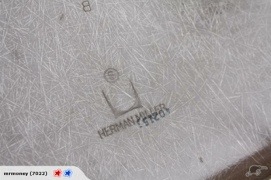Trade Me item – Charles and Ray Eames DSX Chairs
This Trade Me auction is advertised as a pair of genuine Charles and Ray Eames DSX chairs, circa 1948.
This style of chair was designed in the years after the second world war. This was a time of strong economic recovery, an expanding middle class with an insatiable appetite for new products and a cultural environment of reconstruction after the war. Industrial design expanded during this time, and military technologies were applied to domestic products. (Raizman, D., 2011). Mechanised production and industrial technologies improved efficiency and new industrial materials such as plastic, fiberglass and plywood with production techniques such as molding were employed to create furniture that “implied comfort, technological innovation and the forms of modern abstract art”. (p256, Raizman, D., 2011). Designers defined their approach as “fitness for purpose”, and were interested in “designing for the ease and comfort of human use”. (p257, Raizman, D., 2011).
According to Bhaskaran, the Eameses’ were prominent figures in the organic design style (1930 – 1960, 1990 – present) and biomorphic esthetic (1935 – 1955) during the time the DSX chair was designed. (Bhaskaran, L., 2005).
Organic design is characterized by soft, flowing ergonomic lines and sculptural forms, “holistically conceived designs that relate to their surrounding environment”, and the use of natural and synthetic materials “that can be easily molded into organic forms”. It is “inspired by new manufacturing processes and new materials” and a belief that the piece “should connect visually and functionally” with both building and interior. (p146, Bhaskaran, L., 2005). Biomorphism was characterized by its use of high-tech materials, flowing natural forms, sympathy to the human body, and in the 1940s the formal aspects of biomorphism were revealed through the use of new manufacturing and production techniques and new materials like plastic, fiberglass and plywood, which saw it regarded as an “integral part of the machine esthetic”. The Eameses’ “pioneered the style through the use of plastic materials in furniture manufacturing”. (p160, Bhaskaran, L., 2005). The DSX chair exhibits the use of new materials and manufacturing technologies at the time through its organically shaped molded fiberglass seat with “waterfall seat edge” designed for comfort and extended use. As such it manages to fit a number of the characteristics of both design styles, due to the very similar characteristics of the two styles.
References:
Bhaskaran, L. (2005). Designs of the times: Using key movements and styles for contemporary design. Switzerland: Rotovision SA.
Raizman, D. (2011). History of modern design (2nd Ed.). New Jersey, United States: Prentice Hall, Pearson Education, Inc.
MrMoney, Trade Me. (2012). A pair of genuine Charles and Ray Eames DSX chairs. Listing #: 468867129. Retrieved from: http://www.trademe.co.nz/antiques-collectables/furniture-woodenware/furniture/19001949/auction-468867129.htm
Design Within Reach. (2012). Eames molded plastic 4 leg side chair (DSX). Retrieved from: http://www.dwr.com/product/eames-molded-plastic-4-leg-side-chair-dsx.do?sortby=ourPicks









